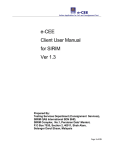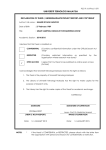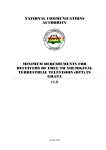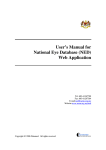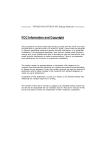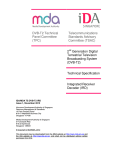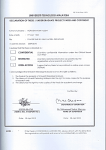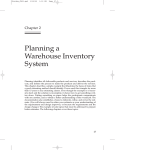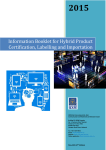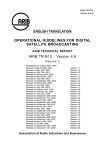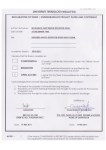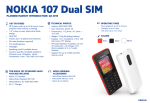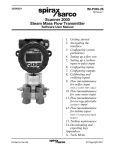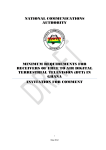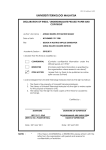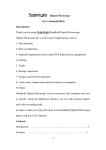Download technical specification for digital terrestrial television receiver
Transcript
SKMM MTSFB TC T004:2013
TECHNICAL CODE
SPECIFICATION FOR
DIGITAL TERRESTRIAL TELEVISION BROADCAST SERVICE
RECEIVER
First Revision
Developed by
Registered by
Issued date: 31 January 2013
© Copyright 2013
SKMM MTSFB TC T004:2013
DEVELOPMENT OF TECHNICAL CODES
The Communications and Multimedia Act 1998 (‘the Act’) provides for Technical Standards Forum
designated under section 184 of the Act or the Malaysian Communications and Multimedia
Commission (‘the Commission’) to prepare a technical code. The technical code prepared pursuant to
section 185 of the Act shall consist of, at least, the requirement for network interoperability and the
promotion of safety of network facilities.
Section 96 of the Act also provides for the Commission to determine a technical code in accordance
with section 55 of the Act if the technical code is not developed under an applicable provision of the
Act and it is unlikely to be developed by the Technical Standards Forum within a reasonable time.
In exercise of the power conferred by section 184 of the Act, the Commission has designated the
Malaysian Technical Standards Forum Bhd (‘MTSFB’) as a Technical Standards Forum which is
obligated, among others, to prepare the technical code under section 185 of the Act.
A technical code prepared in accordance with section 185 shall not be effective until it is registered by
the Commission pursuant to section 95 of the Act.
For further information on the technical code, please contact:
Malaysian Communications and Multimedia Commission (SKMM)
Off Pesiaran Multimedia
63000 Cyberjaya
Selangor Darul Ehsan
MALAYSIA
Tel: +60 3 8688 8000
Fax: +60 3 8688 1000
http://www.skmm.gov.my
OR
Malaysian Technical Standards Forum Bhd (MTSFB)
L2-E-11, Lab 3, Digital Media Centre
Enterprise 4
Technology Park Malaysia
Lebuhraya Puchong –Sg Besi
Bukit Jalil
57000 Kuala Lumpur
MALAYSIA
Tel: +60 3 8996 5505/5509
Fax: +60 3 8996 5507
http://www.mtsfb.org.my
i
SKMM MTSFB TC T004:2013
CONTENTS
Committee Representation ................................................................................................................... iii
Foreword ............................................................................................................................................... iv
Introduction............................................................................................................................................ 1
1.
Scope .......................................................................................................................................... 1
2.
References .................................................................................................................................. 3
3.
Requirement ................................................................................................................................ 4
Acknowledgement ............................................................................................................................... 25
Figures
Figure 1. Channel map when there is a valid LCN descriptor ............................................................ 14
Figure 2. Channel map when LCN descriptor is not broadcasted ...................................................... 14
Figure 3. User experience during channel list selection ..................................................................... 16
Tables
Table 1. References .............................................................................................................................. 6
Table 2. AFD ........................................................................................................................................ 8
Table 3. Decoding Options.................................................................................................................... 8
Table 4. Multi-language support ........................................................................................................... 9
Table 5. Frequency range and bandwidth .......................................................................................... 10
Table 6. DVB-T2 operating modes ..................................................................................................... 11
Table 7. Channel list example ............................................................................................................. 15
Table 8. DVB identifiers ...................................................................................................................... 21
Annexes
A.1 RF Profile for Malaysia ................................................................................................................. 22
A.2 Performance Figures for Malaysia ................................................................................................ 23
ii
SKMM MTSFB TC T004:2013
Committee Representation
Multimedia Terminal Working Group under the Malaysian Technical Standards Forum Bhd (MTSFB)
which developed this Technical Code consists of representatives from the following organisations:
Al Hijrah Media Corporation (TV Alhijrah)
Asiaspace Sdn. Bhd.
BVD Systems Sdn. Bhd.
Conax AS Asia Pacific
Digital TV Labs Limited
LG Electronics (M) Sdn. Bhd.
ManQana Sdn. Bhd.
Measat Broadcast Network Sdn. Bhd. (ASTRO)
Media Prima Berhad
Panasonic R&D Centre Malaysia Sdn. Bhd.
Radio Television Malaysia (RTM)
Rohde & Schwarz Malaysia Sdn. Bhd.
SIRIM Berhad
Sony EMCS (M) Sdn. Bhd.
Strategy and Technology
Telekom Malaysia Berhad
Telekom Research & Development Sdn. Bhd.
U Mobile Sdn. Bhd.
U Television Sdn. Bhd.
Y&R
iii
SKMM MTSFB TC T004:2013
FOREWORD
This technical code for the Specification for Digital Terrestrial Television Broadcast Service Receiver
(‘this Technical Code’) was developed pursuant to section 185 of the Act 588 by the Malaysian
Technical Standard Forum Berhad (‘MTSFB’) via its Multimedia Terminal Working Group.
This Technical Code was developed for the purpose of certifying communications equipment under
the Communications and Multimedia (Technical Standards) Regulations 2000.
This Technical Code cancels and replaces Technical Specification Digital Terrestrial Television
Receiver, SKMM WTS STB-FTA Rev. 1.01:2008.
This Technical Code shall continue to be valid and effective until reviewed or cancelled.
iv
SKMM MTSFB TC T004:2013
SPECIFICATION FOR DIGITAL TERRESTRIAL TELEVISION BROADCAST
SERVICE RECEIVER
Introduction
Proposition
This document outlines receiver specification which is capable of receiving both Standard Definition
and High Definition Digital Terrestrial broadcast for Malaysia.
Items in this specification are divided into ‘Required’ and ‘Optional’ categories. Where a feature is
stated as ‘Required’, its inclusion is necessary for the achievement of a minimum compliance with
transmission requirements. Additional Optional functions may be added by the vendor to enhance the
consumer proposition and these will be welcomed. In order to be compliant, where a feature is
‘Optional’ and is included in an offered receiver design, the optional feature must be implemented in
accordance with the associated referenced standards. The word “shall” implies that the item is a
requirement (mandatory) while the word “may” implies that a requirement is optional.
The term basic profile in this document refers to the profile for receivers which do not implement the
interactive application as outlined by 3.2.18.
This specification is not a comprehensive list of all relevant standards relating to consumer equipment
that can provide digital terrestrial reception but rather a list of those standards considered relevant to
requirements.
The profile is based upon open standards predominantly from the Digital Video Broadcasting (DVB)
standards and the European Telecommunications Standards Institute (ETSI).
Purpose
The purpose of this document is to describe the requirements for a certified Free to Air Terrestrial
receiver for Malaysia and to refer to detailed specifications that are required for conformant
implementation. The profile is in the form of a hardware specification outline, together with an
overview of software requirements. The software is to be routinely capable of being upgraded via
‘through-the-air-download’.
1.
Scope
The document sets out to identify the baseline functional specification of a H.264 AVC HD digital
terrestrial receiver including both Set Top Boxes and IDTV’s. Personal Video Recorders (PVRs) are
outside the scope of this document. It is intended that a terrestrial receiver conforming to this profile
should comprise part of a domestic installation, in conjunction with an external, fixed wideband
terrestrial UHF/VHF antenna input. Set Top Box output(s) will connect to the television display (and
possibly other domestic equipment).
It is the aim of the specification to ensure that the approved receiver in Malaysia satisfies the
minimum requirements of each broadcaster.
1
SKMM MTSFB TC T004:2013
1.1
Abbreviations
AFD
AC-3
CVBS
D-Book
BER
C/N
CLUT
CVBS
DTS
DTT
DVB
DVB-CI
DVB-T
DTG
E-AC-3
EBU
EPG
EIT
FEC
FFT
FTA
HDCP
HDMI
HDTV
HE AAC
HE AAC v2
IRD
iDTVs
MHEG-5
MHEG
May
MP@HL
MP@ML
MPEG
Must
NIT
OSD
(Opt)
PAL
QAM
QPSK
(Req)
RF
RS
SD
Active Format Descriptor
Dolby AC-3 audio coding system
Composite Video Blanking and Synchronization
See technical standards listed elsewhere in this document
Bit Error Rate
Carrier to Noise Ratio
(DVB) Colour Look Up Table
Composite Video Baseband Signal
DTS audio coding system
Digital Terrestrial Television
Digital Video Broadcast
DVB-Common Interface
DVB-Terrestrial
Digital Television Group – a UK digital television industry organisation
Enhanced AC-3
European Broadcasting Union
Electronic Programme Guide
Event Information Table
Forward Error Correction
Fast Fourier Transform
Free to Air
High-Bandwidth Digital Content Protection
High-Definition Multimedia Interface
High Definition Television
High Efficiency Advanced Audio Coding
High Efficiency Advanced Audio Coding Version 2 profile
Integrated Receiver Decoder
Integrated Digital Televisions
A standard devised for the middleware for interactive services.
stands for “Multimedia and Hypermedia information coding Expert Group”
Indicates an event or provision which is permitted, but not mandatory
Main Profile at High Level
Main Profile at Main Level
Moving Pictures Expert Group
Indicates that a third party must comply to ensure correct operation
(present tense) Indicates an existing provision
Network Information Table
Onscreen Display
Optional
Phase Alternating Line
Quadrature Amplitude Modulation
Quadrature Phase Shift Keying
Requirement
Radio Frequency
Reed-Solomon
Standard Definition
2
SKMM MTSFB TC T004:2013
SDT
SDTV
SFN
SI
S/PDIF
SSU
STB
Shall
Should
(TS)
UHF
Y/C
YCbCr/YPbPr
Will
2.
(DVB) Service Description Table
Standard Definition Television
Single Frequency Network
Service Information
Sony/Philips Digital Interface
System Software Update
Set-Top-Box, which is equivalent to a digital Terrestrial receiver
Indicates a mandatory provision
Indicates a desirable, but not mandatory, provision
Transport Stream: A data structure defined in ISO/IEC 13818-1
Ultra-High Frequency
S-Video Signal
Component Video Signal
Indicates an assumption about existing states or future events
References
[1] Commission Determination on the Mandatory Standard for Free To Air Transmission of Digital
Terrestrial Television Service (Suruhanjaya Kommunikasi dan Multimedia Malaysia – SKMM).
[2] HDMI “High-Definition Multimedia Interface; specification Version 1.4”
[3] HDCP “High-Definition Digital Content Protection System Revision 1.4”
[4] ETSI EN 300 468 V1.12.1 Digital Video Broadcasting (DVB); Specification for service information
(SI) in DVB systems
[5] ETSI TS 101 211 V1.11.1 Digital Video Broadcasting (DVB); Guidelines on implementation and
usage of Service information (SI)
[6] EN 302 755 V1.3.1 Digital Video Broadcasting (DVB); Frame structure channel coding and
modulation for a second generation digital terrestrial television broadcasting system (DVB-T2)
[7] ETSI TS 101 154 V1.10.1 Digital Video Broadcasting (DVB); Specification for the use of Video and
Audio Coding in Broadcasting Applications based on the MPEG-2 transport stream
[8] ETSI ETR 162 Digital broadcasting systems for television, sound and data services; Allocation of
Service Information (SI) codes for Digital Video Broadcasting (DVB) systems.
[9] ETSI 300 743 v1.3.1 Digital Video Broadcasting (DVB); DVB Subtitling systems.
[10] ISO/IEC 14496-10 2005 Information Technology – Coding of audio visual objects – part 10 –
Advanced Coding
[11] SKMM MTSFB TC G002:2013 Middleware Profile for Digital Terrestrial Television Broadcast
Service
[12] SKMM MTSFB TC G001:2013 Compression Table of Service Information (SI) Descriptions for
Digital Terrestrial Television Broadcast Service
[13] CI Plus Specification. Content Security Extensions to the Common Interface. V1.3
3
SKMM MTSFB TC T004:2013
[14] ETSI TS 102 006 (V1.3.2) Digital Video Broadcasting; Specification for System Software Update
in DVB Systems.
[15] ETSI TS 102 366 (V1.1.1) Digital Audio Compression (AC-3, Enhanced AC-3) Standard
[16] ISO/IEC 14496-3:2009 Information Technology – Coding of audio visual objects – part 3: Audio
2.1
Overview
This specification uses as a reference a number of national and international standards from the DVB,
ETSI, ISO and other standardization bodies to create a Malaysian Digital Broadcast profile. It does not
intent to create a set of unique specifications unless deemed necessary by the commercial realities in
Malaysia.
3.
Requirement
3.1
General Requirement
3.1.1
Power Supply
The receiver may be AC or DC powered. For AC powered equipment, the operating voltage shall be
240 V +5 %, -10 % and frequency 50 Hz ± 1 % as according to MS 406 or 230 V ± 10 % and
frequency 50 Hz ± 1 % as according to MS IEC 60038 whichever is current. (Req)
Where external power supply is used, e.g. AC adaptor, it shall not affect the capability of the receiver
to meet this specification. Adaptor must be pre-approved by the relevant regulatory body before it can
be used with the receiver. (Req)
3.1.2
Power Supply Cord and Mains Plug
The receiver shall be fitted with a suitable and appropriate approved power supply cord and mains
plug. Both are regulated products and must be pre-approved by the relevant regulatory body before it
can be used with the receiver. (Req)
The power supply cord shall be certified as according to:
a) MS 140; or
b) BS 6500; or
c) IEC 60227-5; or
d) IEC 60245-4.
The main plug shall be certified as according to:
a) 13 A fused plugs: MS 589: Part 1 or BS 1363: Part 1; or
b) 15 A plugs: MS 1577 or BS 546; or
c) 2.5 A, 250 V, flat non-rewirable two-pole plugs: MS 1578 or BS EN 50075.
4
SKMM MTSFB TC T004:2013
3.1.3
Electromagnetic Compatibility
The receiver shall comply with the EMC emissions requirements as defined in the MS CISPR 13 or
equivalent international standards. The requirements shall cover radiated and conducted emission.
(Req)
3.1.4
Electrical Safety
The receiver shall comply with the safety requirements as defined in MS IEC 60065. The supplier
shall submit full type test report of MS IEC 60065 or equivalent international standards. (Req)
3.1.5
Marking
The receiver shall be marked with the following information:
a) supplier/manufacturer’s name or identification mark;
b) supplier/manufacturer’s model or type reference; and
c) other markings as required by the relevant standards.
The markings shall be legible, indelible and readily visible. All information on the marking shall be
either in Bahasa Malaysia or English Language. (Req)
3.2
Technical Requirement
3.2.1
Processor and Memory
The processing power and memory configuration of the receiver must be suitable for the routine
operation of FTA digital Terrestrial reception, (DVB-T2), together with the embedded operation of the
interactive application and the provision of the routine replacement of all software via “over-air
download”. The related parameter limits specified in this section are believed to be the minimum
necessary to achieve these requirements.
3.2.1.1 DDRAM
: 64 Mbytes, Minimum baseline functionality
3.2.1.2 Flash
: 8 Mbytes, Minimum baseline functionality
3.2.1.3 CPU Processor Speed
: 300MHz, Minimum baseline functionality
3.2.2
Services Summary
The receiver must give access to all Malaysian free-to-view digital terrestrial television, radio and
enhanced/interactive television services. This must include the capability to efficiently present radio
channels, DVB subtitles and interactive elements of all services. It must present DVB subtitles when
broadcasted and if requested by the viewer. Set top boxes shall also be able to manage the output
video in both widescreen 16:9 and 4:3 picture formats to suit the connected display. Where possible,
receivers should be able to present both subtitles and interactive graphics simultaneously. However,
not all receivers may be able to do this, the result being that interactive content will not always be
available to viewers that wish subtitles to be presented.
3.2.2.1 Time-exclusive Services
The receiver shall handle the transition between the active and inactive states of a time exclusive
service in an orderly fashion, presenting clean transitions into and out of video, audio and inter-active
5
SKMM MTSFB TC T004:2013
content streams without presentation of any content or application not intended for the selected
service.
3.2.3
Video
3.2.3.1 Video Codec
The following codec shall be supported by a compliant receiver. The codec are outlined below and
further constraint by [7] TS 101 154. Only clauses 5.5, 5.6 & 5.7 shall apply.
MPEG4 video: H.264 AVC Encoding, as ISO/IEC 14496-10 2005 (Information Technology – Coding
of audio visual objects – part 10 –Advanced Coding) - (Req)
The profiles that shall be supported are as follows.
MPEG-4 AVC MP@L3 SD Video stream
MPEG-4 AVC HP@L4 HD Video stream
3.2.3.2 Resolutions
The following resolutions shall be supported by a compliant receiver.
Table 1. References
Format
Resolution
Frame Rate
(Field rate)
Progressive /
Interlaced
Aspect Ratio
1080i/25
Refer to [7]
clause 5.7
25Hz (50 Hz)
Interlaced
16:9
720p/50
Refer to [7]
clause 5.7
50Hz (50 Hz)
Progressive
16:9
576i/25
Refer to [7]
clause 5.6
25Hz (50 Hz)
Interlaced
16:9 & 4:3
3.2.3.3 Output Resolution Control for Set Top Boxes
Set Top Boxes shall provide either via the Menu System and/or Remote control an option to change
the output video format as required by the user. The receiver is to perform a down-conversion or upconversion from any valid input resolution to a user selected video resolution output. If the Video
Output format option is in the menu structure of the receiver for the user to manually select then a
pop-up message will appear to confirm the selection or reset automatically to the default selection
after a time-out period (similar to changing the output format change display in windows operating
system).
3.2.3.4 Widescreen
Set Top Boxes and IDTV’s that optionally support Analogue outputs may format the outputs for
displays which are either 16:9 or 4:3. Both may also carry out a suitable rescaling of the video to 14:9
when working with SD outputs on a 4:3 display.
6
SKMM MTSFB TC T004:2013
3.2.3.5 Active Format Description
Table 2. AFD
The receiver shall support at least the Active Format Description (AFD) outlined in the table above as specified by [7] Appendix B.
7
SKMM MTSFB TC T004:2013
3.2.4
Audio
3.2.4.1 Codec Support
Enhanced Dolby Digital (E-AC3), based on ETSI TS 102 366 [15] and signaled by TS 101 154 [7],
Annex C and constrained by clause 6.2. Sampling rates shall be restricted to 32, 44.1 & 48kHz (Opt)
Only pass through of AC-3 audio to the Digital Audio Connector is required when E-AC3 is supported
(Req).
MPEG-4 HE AAC audio for services will be encoded according to ISO/IEC 14496-3 [16] and
signaled/constrained by ETSI TS 101 154 [7], section 6.4 and Annex C.5.
Stereo only receivers shall support MPEG-4 HE AAC v2 level 4 decoding including mandatory
downmix and support of metadata as defined in ETSI TS 101 154 section 6.4.3 and Annex C.5. (Req)
Multichannel capable receivers shall support MPEG-4 HE AAC v2 level 4 decoding including
mandatory transcoding into either AC-3 or DTS and support of metadata as defined in ETSI TS 101
154 section 6.4.3 and Annex C.5. (Opt)
3.2.4.2 Decoding Options
Table 3. Decoding Options
Codec
Analogue Output
/ Speaker (IDTV)
Optical/Coaxial
HDMI*
E-AC3
Down-Mixed.
(Optional)
AC-3 transcoded
bitstream and pass
through. (Optional)
E-AC-3 Bitstream
pass through
(Optional).
HE-AAC v2
(Stereo)
Decode
(Requirement)
Stereo PCM or
bitstream pass
through
(Optional)
Stereo PCM or
bitstream pass
through
(Requirement)
HE-AAC v2
(multichannel)
Down-Mixed
(Requirement)
Transcode to AC-3
or DTS Bitstream
and pass
through.(Optional)
Transcode to AC-3
Bitstream and pass
through. (Optional)
NOTES: The above implies that if E-AC3 is broadcasted, it shall always be simulcast with HE-ACC.
*Only applicable if HDMI output is implemented by the receiver.
3.2.5
Subtitles
A compliant receiver shall be able to decode DVB subtitles according to the specification outlined in
[9].
DVB subtitles shall be invoked from a suitable labeled remote control key which is always under the
control of the receiver and not controlled by the Middleware application.
All receivers shall also be capable of decoding and presenting correctly subtitles streams which
include the display_definition_segment (DDS) as outlined in [9] (Req).
8
SKMM MTSFB TC T004:2013
3.2.5.1 Display of Subtitles during Enhanced Programming
Subtitles shall be displayed on a separate logical graphics plane separate from that used for the
interactive application outlined in [11] (Req).
3.2.6
Multi-Language Support
The user shall be provided with Primary and secondary language options for both Subtitles and Audio
selection. The list of languages provided shall as a minimum contain all the languages outlined in the
table below.
Table 4. Multi-language support
Language
ISO 639-3 Code
English
ENG
Bahasa Melayu
MSA
Chinese
ZHO
Tamil
TAM
Original Audio
QAA*
NOTE. * Original Audio is only applicable for Audio.
3.2.6.1 Subtitle Selection
The order of priority for subtitle selection shall be as follows.
(1)
Primary Language.
(2)
Secondary Language.
(3)
Receivers own selection criteria (optional).
The receiver may implement its own selection criteria after (1) & (2) fail to provide a language match.
3.2.6.2 Audio Selection
The order of priority for audio selection shall be as follows:
(1)
Primary Language
(2)
Secondary Language
(3)
Receivers own selection criteria (optional)
The receiver may implement its own selection criteria after (1) & (2) fail to provide a language match.
3.2.7
OSD
The Graphics requirement for the receiver is governed by the graphics requirement of the interactive
middleware application outlined in [11]. Receivers shall meet the minimum requirement outline there
(Req).
This is not a requirement for receivers complying only with the basic profile.
9
SKMM MTSFB TC T004:2013
3.2.8
Receiver Character Set
The receiver shall at least be able to support Table 00 (Latin Alphabet as specified in ISO 6937 which
is reproduced in Appendix A of EN 300 468 [4]).
The broadcast shall not signal any character set selection information by ensuring that the first byte in
any text field is either 0x1F (restricted to EIT tables) or in the range of 0x20 to 0xFF.
The receiver shall support compressed strings within all types of EIT tables. A compressed string shall
be signaled by the method outlined in Appendix A of EN 300 468 [4]. This is done by ensuring that the
nd
first byte of any compressed string is 0x1F. The 2 byte as outlined by [4] shall contain the
encoding_type_id.
Strings marked as compressed shall be compressed using Huffman compression as outlined in [12].
The receiver to decompress these strings will require a look up table. The receiver shall incorporate 2
tables signaled by the encoding_type_id outlined in section 3.2.19.
3.2.9
Common Interface
Receivers may incorporate a DVB-CI (Common Interface) slot. If available, this slot shall be a certified
CI+ slot as outlined in CI+ specification V1.3 [13] meeting all the required robustness rules.
3.2.10 Tuner / Decoder
A DVB-T2 decoder in accordance to T2 base profile of EN 302 755 [6] (Req)
3.2.10.1
RF Input Connector
In accordance to IEC 60169-2 (Req).
3.2.10.2
RF Loop-through
Set Top Boxes may provide an RF loop through. The connector shall be in accordance to IEC 601692 with a typical gain of 0 dB.
3.2.10.3
Input Impedance
75 ohm nominal (Req)
3.2.10.4
Frequency Range and Bandwidth
The receiver shall be able to scan and tune to the following frequency range and bandwidth.
Table 5. Frequency range and bandwidth
Band
Frequency
Bandwidth
VHF
III
174 – 230 MHz
7 MHz
UHF
IV & V
470 – 860 MHz
8 MHz (signal bandwidth of 7.77 MHz
for extended mode and 7.61 MHz for
non-extended mode)
The receiver shall at least be able to receive carriers within an offset of up to 166 kHz from the
nominal centre frequency.
10
SKMM MTSFB TC T004:2013
3.2.10.5
DVB-T2 Operating Modes
The receiver shall support the operating modes as specified by EN 302 755 [6]. The minimum list of
modes for each parameter that shall be supported by the receiver is outlined in the table below. (Req)
Table 6. DVB-T2 operating modes
3.2.10.6
Parameter
Required Modes
Transmission mode
32K Normal & Extended
Constellation
QPSK,16-QAM, 64-QAM & 256 QAM
Constellation Rotation
Rotated and Non Rotated
Code Rate
1/2, 3/5, 2/3, 3/4, 4/5, 5/6
Guard Interval
Tu*19/128, Tu/8, Tu*19/256, Tu/16, Tu/32, Tu/128
Pilot Pattern
PP2, PP4, PP6 & PP7
Antenna
SISO & MISO
PAPR
No PAPR & TR-PAPR
FEC Frame Length
16200 & 64800
Input Mode
Input Mode A & B (Single PLP, Multiple PLP)
Baseband Mode
Normal Mode, High Efficiency Mode
Multiple PLP Feature Requirements
The receiver shall support at least the following features related to Multiple PLP as outlined in [6].
(1) Both PLP Type 1 & 2
(2) The receiver should be able to support SI information broadcasted in both the Common as well as
the Data PLP.
(3) Receiver shall at least be able to decode one data PLP and the common PLP at any one time.
3.2.10.7
Receiver DVB-T2 Performance Requirement
The performance requirements for this section shall meet the RF requirement based on the list of
modes outlined in Annex A.
3.2.11 Service List
After a receiver is installed it must offer the viewer all services that may be received in that geographic
region compliant with the regional services requirement. The services being broadcast may change
over time. To ensure that the viewer will always be able to access all services being broadcast to the
selected region, the receiver must detect and reflect to the viewer any such changes with minimal
viewer involvement. All services have an associated (Logical) Channel Number. Use of the logical
channel number ensures that the viewer becomes familiar with a specific remote control unit button
number for each channel. Access to, and use of, accurate service information is essential if the viewer
is to enjoy all of the content being broadcast.
11
SKMM MTSFB TC T004:2013
3.2.11.1
Scanning for Services
The receiver shall provide a method for the user to install all services which clears any previous
service list that might exist. During this installation process, the receiver shall scan for the RF
channels outlined in this document.
When a lock is achieved on a channel, the receiver shall obtain the list of services for the current
multiplex from SDT actual. This process shall be repeated till the whole frequency range is complete.
3.2.11.2
Logical Channel Number Descriptor
LCN information shall be broadcasted via a privately defined LCN descriptor as outlined below. This
descriptor shall be broadcasted in the TS Loop of the NIT on all multiplexes.
logical_channel_descriptor() {
descriptor_tag
descriptor_length
for (i=0;i<number_of_services;i++){
service_id
visible_service_flag
reserved
logical_channel_number
}
}
8 (uimsbf)
8 (uimsbf)
16 (uimsbf)
1 (bslbf)
5 (bslbf)
10 (uimsbf)
descriptor_tag : this shall be assigned the value 0x83
visible_service_flag : 1: visible 0:Not Visible
reserved : all reserved bits shall be set to 1. The receiver shall ignore these bits.
service_id : DVB defined service id.
3.2.11.3
Logical Channel Descriptor V2
The LCN V2 privately defined descriptor may be broadcasted. This descriptor contains additional
information related to sorting of services depending on region. Receivers shall support this descriptor
if broadcasted.
descriptor_tag: This shall be 0x87 (decimal 135)
channel_list_id: This 8-bit id shall uniquely define the Logical Channel List for a particular region.
This id shall be unique within the Original Network.
channel_list_name_length: This 8-bit field specifies the number of bytes that follow the
channel_list_name_length field for describing characters of the name of the Channel List. The
maximum length of the channel list name shall be 23 bytes.
char: This is an 8-bit field. A string of character fields specify the name of the channel list, the
channel_list_name. (channel_list_name shall have a maximum length of 23 characters). Text
information shall be coded using character table 00 as defined in Annex A of EN 300 468.
12
SKMM MTSFB TC T004:2013
country_code: This 24-bit field identifies a country using the 3-character code as specified in ISO
3166. Each character is coded into 8-bits according to ISO 8859-1 and inserted in order into the 24-bit
field. This shall be set to “MYS”.
service_id: A service_id that belongs to the TS (i.e. services from transport streams not in the current
loop shall not appear). One service may only be listed once in each channel list, but may belong to/be
listed in more than one channel list.
visible_service_flag: 1: visible 0:Not Visible
reserved: All “reserved” bits shall be set to ’1’. The receiver shall ignore these bits.
logic_channel_number: This is the broadcasters preferred Logical Channel Number for the service
in question. Rules of operation are as per LCN Management section of this specification.
Logical_channel_v2_descriptor (){
descriptor_tag
descriptor_length
for (i=0;i<N;i++){
channel_list_id
channel_list_name_length
for (i=0;i<N;i++) {
char
}
country_code
descriptor_length
for (i=0;i<number_of_services;i++){
service_id
visible_service_flag
reserved_future_use
logical_channel_number
}
}
}
3.2.11.4
8
8
Uimsbf
Uimsbf
8
8
Uimsbf
Uimsbf
8
Uimsbf
24
8
Uimsbf
Uimsbf
16
1
5
10
Uimsbf
Bslbf
Bslbf
Uimsbf
Channel Numbering
The Logical Channel Numbers shall be obtained from the LCN descriptor as outlined above. The
channel map shall be from 1-999 with valid LCN’s being assigned in the range from 1-799 by the
broadcaster. The details of the channel map are outlined below.
13
SKMM MTSFB TC T004:2013
LCN Range 1-799
Services Assigned as per
Logical Channel
Descriptor.
Will contain all types of
services including
Radio/Data/Video
Main Area
In-country invalid LCN
Foreign Services
LCN Range 800-999
Services inserted based
rules outlined here.
Overflow Area
Duplicate Services
Figure 1. Channel map when there is a valid LCN descriptor
Main Area: Services shall be ordered here according to the channel map as described by the Logical
Channel Descriptor. If no valid Logical Channel Descriptor exists, please refer to the no logical
channel descriptor section below.
Overflow area: Below is the list of different categories within the overflow area.
In country invalid LCN: Any service which has not been assigned a Logical Channel Number or has
been assigned a number outside the valid range of 1-799, shall be placed in the overflow area. This
section should only be used when there is a valid Logical Channel Descriptor within the network.
Please refer to the no logical channel descriptor section below.
Foreign Services: Any service belonging to an original network other than the in country original
network shall be placed in the overflow area.
Duplicate Services: If two or more unique services (unique DVB triplet) are assigned the same
Logical Channel Number the service belonging to the multiplex with the best RF quality shall be
placed in the LCN assigned by the Logical Channel descriptor. All other services shall be placed in
this category of the overflow area.
Receivers may implement their own ordering of services within the overflow area.
When no logical channel descriptor is found within the in country Original Network, all in country
services shall be assigned Logical Channel Numbers in any order sequential from 1 onwards.
In Country Services
1~N
Sequentially ordered
Foreign Services
N+1 ~
Sequentially ordered
Figure 2. Channel map when LCN descriptor is not broadcasted
14
SKMM MTSFB TC T004:2013
Services from the original network of foreign countries shall be placed immediately after the last in
country service.
When there are duplicate services (same DVB triplet) only the service from the multiplex with the best
RF quality shall be visible to the user, the duplicate shall not be assigned a logical channel number.
3.2.11.5
Regional Broadcast Management
A regional multiplex might contain one or more services which have events that differ from one region
to another.
The receiver shall decode the Logical Channel Descriptor Version 2 as outlined above.
During initial install, all channel lists for the country selected by the user shall be collated by the
receiver. Once the scan is complete, if there is more than 1 valid channel list, the user shall be given a
method to select a preferred list. The wording of the selection items presented to the user shall
include the 23 character string broadcasted in the descriptor.
The receiver shall then order the services based on the selected channel list.
Example:
Table 7. Channel list example
channel_list_id
0x00
channel_list_name
Central Region
Service ID Service Name
0x1001
News Central Region
0x2001
National Entertainment
0x2002
National Documentaries
0x1002
News Southern Region
0x1003
News Northern Region
LCN
001
002
003
100
101
channel_list_id
0x01
channel_list_name
Northern Region
Service ID Service Name
LCN
0x1001
News Central Region
100
0x2001
National Entertainment
002
0x2002
National Documentaries
003
0x1002
News Southern Region
101
0x1003
News Northern Region
001
channel_list_id
0x02
channel_list_name
Southern Region
Service ID Service Name
LCN
0x1001
News Central Region
101
0x2001
National Entertainment
002
0x2002
National Documentaries
003
0x1002
News Southern Region
001
0x1003
News Northern Region
100
In the example above, the news service with regional variation is being broadcasted on 3 services.
Based on the user selection the receiver shall be able to place at the most appropriate service in the
main LCN slot. The screen shots below gives a feel for the process that the user should experience
and the interaction expected between the user and the receiver.
15
SKMM MTSFB TC T004:2013
Figure 3. User experience during channel list selection
In this example, a news channel has 3 regional variations, Central, Northern and Southern. The
service for the users own region should be placed at LCN 1 while the services for the other regions if
the receiver is able to receive them shall be placed at LCN 100 onwards.
If the services for other regions are not included in the list, according to LCN ordering rules, these
services shall be moved into the overflow region.
16
SKMM MTSFB TC T004:2013
3.2.11.6
Network Evolution
The service line up of the network is considered to be quasi static. The receiver shall update the
service list according to the rules outlined below to enable the broadcaster to evolve the network as
necessary. Network evolution will occur frequently during analogue switch off requiring the receiver to
be able to track changes in the network.
The receiver is required only to update its service list when it is possible for it to do a complete scan
without interruption to viewer’s usage of the receiver. However the receiver may do a partial update of
the service list if this does not cause disruption to the viewer.
Service Addition/Deletion
Services shall be added and deleted according to the Service line up in the SDT actual.
Multiplex Addition
During the network evolution scan if a new multiplex is found, the services in the multiplex shall be
added to the service list.
Multiplex Deletion
During the network evolution scan if a multiplex which was previously in the network list is no longer
found the receiver shall delete all the services in the multiplex from the user service list.
Receivers may optionally implement measures to ensure that a multiplex is not deleted due to the
temporary non availability of a multiplex due to transient broadcast conditions (example rain).
Concerns regarding temporary lost of multiplexes shall take precedence over the requirement above,
Clash Resolution
The basic rules of operation shall follow the rules as outlined in the LCN management section.
In addition to this the receiver shall also conform to the following rule of operation.
(1) If a new service was found during the network evolution scan and if the assigned LCN is already
being used by another service. The new service shall take precedence if the current service was
not found during the same scan.
The receiver may give priority to services which have been moved or added by the user instead of
following the rules above.
3.2.11.7
Selection via Service List
The initial displayed service list following a full automatic scan must present services in ascending
order of LCN (Req)
3.2.11.8
Hidden Services
Services identified as “not visible” in the LCN descriptor shall not appear in the service list presented
to the viewer. However such services may be selectable by direct numerical entry. (Req)
3.2.12 EPG
17
SKMM MTSFB TC T004:2013
3.2.12.1
EPG “Now/Next”
‘Now / Next’ screen guide shall be derived using information from DVB SI EITp/f tables as per EN 300
468 [4]. The presentation of the now/next banner is as per manufactures chosen user interface but it
is desirable for the following information to be displayed in the bottom third of the screen.
Current time
Start time of now and next programme
End time of now and next programme
Logical Channel Number
Channel Name
Date
Event name
Short description
Extended description
Genre
Sub-genre
Parental ratings
The EPG “Now and next” shall be displayed when the user launches the application via the i (info)
button on the remote control. If a descriptor is missing from the EIT table – the receiver shall not
display an error message. (Req)
The EPG “Now and next” may be displayed when the user changes channels for approx 2 secs. (Opt)
3.2.12.2
EPG “Schedule”
The receiver shall be able to capture and display at least 7 days of EPG based on broadcasted EIT
schedule information. EIT information capture shall be done in the background continuously. This will
enable the receiver to display the Full EPG as soon as the EPG button is pressed.
3.2.13 Clock
The receiver shall be able to display real time clock/calendar information. The clock information shall
be updated by the incoming TDT and TOT table in the SI. The receiver shall display the clock in local
time. (Req)
3.2.14 Set-up
3.2.14.1
Easy to Use and Simple Documentation
Receivers shall be simple to set up and operate and be provided with clear easy to understand user
documentation in line with that requirement. (Req)
3.2.14.2
Support Package
The following peripheral items should be included within a baseline receiver package:
An RF lead/cable for connection of loop-through connector to a second receiver (500mm min
length; male F-connectors each end). This is optional for receivers that have a loop through
connector.
18
SKMM MTSFB TC T004:2013
Set top boxes shall provide a Composite (CVBS) and stereo audio RCA cable. (1m min
length).
Set Top boxes which provide a Component video output may provide a Component Video
Cable with stereo audio RCA cable(s) (1m min length).
Set Top Boxes may provide a HDMI Cable.
Remote control and batteries. (Req)
An easy to understand user manual in English language in either paper or electronic form. If
an electronic user manual is provided, there must be a quick installation guide and the
electronic user manual must be viewable on the device (Req)
Receivers may provide a Coaxial cable or optical cable for digital audio (Opt)
3.2.15 Outputs
3.2.15.1
Primary Output
A set top box receiver shall have at least one HDMI output with HDCP. It is optional for IDTV’s to have
HDMI output(s).
The HDMI profile used by the Set Top Box shall be able to at least output the highest resolution
supported by the Set Top Box.
3.2.15.2
Secondary Output
In addition set top boxes shall have the following:
RCA (phono) providing composite (CVBS) video. Shall meet the characteristics in ITU report
624-4 (Req)
Receivers may provide the following and if provided, it shall conform to copy protection rules in
3.2.15.5.
RCA (phono) providing Component YPbPr output. If available shall meet the characteristics in ITU
report 624-4 (Opt)
3.2.15.3
Analogue Phono Audio
Set top boxes shall provide RCA Audio left (Colour – white) & Right (Colour –Red) connectors.
3.2.15.4
Digital Audio Output
SPDIF for pass through (transcoded output) of Dolby Digital (AC-3) either on Optical and/or Coaxial
Digital Audio Output(s). Manufactures are requested to state connector type. (Optional)
3.2.15.5
Copy Protection on outputs
The receiver shall provide HDCP digital content protection on the HDMI output for all output
resolutions. The receiver is not to output any HD format on any analogue video outputs.
An HD format is defined as any signal having a luminance resolution as defined in [7] TS 101 154
Clause 5.7.
19
SKMM MTSFB TC T004:2013
3.2.16 Remote Control
A Remote Control is to be supplied with the receiver. The manufacturer is free to design the remote.
The Remote Commander shall as a minimum have all the keys mandated for the middleware
application as outlined by [11].
It shall also provide an EPG button for the user to directly launch the EPG.
The keys mandated by the middleware [11] are not a requirement for a receiver complying only with
the basic profile.
3.2.17 Maintenance & Upgrade: Summary
To allow for software changes receivers must be upgradeable in a practical manner, e.g. Over the air
download. The process of upgrading should cause minimal disruption to the viewer. However, to
minimize the diversity of deployed software builds and to most efficiently use the available broadcast
capacity, the receiver must detect and act upon the broadcast of a relevant software download within
24 hours of its transmission commencing.
3.2.17.1
Over Air Download
Support for the use of DVB SSU, to at least the simple profile as defined in ETSI TS 102 006 [14] is
required. (Req) Receivers shall be able to handle the presence of software downloads in any NIT
referred carrier signal. (Req)
Receivers shall be capable of automatic (i.e. not user initiated) software upgrade by over-air download
with minimal interruption to the viewer. (Req)
Manufacturers shall ensure that the receiver offered shall only respond to a unique OUI code,
(Organisation Unique Identifier). This means that the receiver offered shall not react to any other OUI
from any other manufacturer nor react to any other OUI from the same company which relates to a
different model receiver.
The default DVB-SSU mode for receivers shall be with DVB-SSU “enabled”.
For Conformance testing manufacturers will be required to deliver two ASI transport streams
containing relevant converted binary image files, together with all relevant NIT and PMT data
necessary for their receiver to properly undergo a successful DVB-SSU operation. One stream will
replace the software in the receiver as demonstrated by a new version number, or some other visible
indicator, the other will restore the receiver to its then current configuration.
3.2.17.2
User Software Upgrade
The receiver shall provide one or more of the following data interfaces to enable the user to perform
software upgrades.
Universal Serial Bus (USB)
RJ 45 (Ethernet IEE802.3)
Appropriate Memory Card
3.2.17.3
Status
The receiver shall provide a diagnostic screen triggered by a menu driven option providing the
following basic information:
(1)
Software Version
20
SKMM MTSFB TC T004:2013
RF signal information which may include one or all of the following information, AGC, Pre FEC Bit
Error Rate and/or Post FEC bit Error Rate.
Optionally the receiver may also include the following information:
(1)
Audio PID
(2)
Video PID
(3)
Channel ID
3.2.18
Interactive Application
The receiver shall implement the interactive application outlined in the middleware [11] specification
unless the receiver is only complying to the basic profile requirements (Req).
Interactive only services (data services) shall be signaled with a service type of 0x0C. The SDT shall
also contain a data_broadcast_descriptor with a data_broadcast_id of 0x0123.
Services signaled above, shall be installed in receivers supporting interactive applications as data
only services.
3.2.19 DVB Identifiers
The following DVB identification values shall be used in the broadcast in Malaysia.
Table 8. DVB identifiers
Identifier
Value
Original Network ID
0x21CA
Private Data Specifier
0x0000 21CA
Network ID Range
0x3301 - 3400
Encoding Type ID
English Huffman Table : 0x05
Bahasa Melayu Huffman Table : 0x06
21
SKMM MTSFB TC T004:2013
Annex A
A.1 RF Profile for Malaysia
Identifier
Overall
FFT Size
GI
SISO/MISO
PAPR
Bandwidth
Carrier Mode
Pilot Pattern
L1 Modulation
Data Symbols per Frame (Ldata)
OFDM Symbols per Frame (Lf)
Frame Duration (ms)
Frames Per SuperFrame
PLP #0
PLP Type
Time Interleaver Type (TIME_IL_Type)
Modulation
Rate
FEC Type
Rotated QAM
FEC blocks per interleaving Frame
Full channel (Trial mode)
TI blocks per frame (N_TI)
Frame_Interval (I_JUMP)
TIME_IL_LENGTH
Approx. Time Interleaving Length (ms)
Data Rate (Mbit/s)
22
MS 1
MS 2
MS 3
MS 4
32K
1/8
SISO
TR
8MHz
Extended
PP2
64 QAM
43
44
178
2
32K
19/256
SISO
TR
8MHz
Extended
PP4
64 QAM
61
62
239
2
32K
1/128
SISO
TR
8MHz
Extended
PP7
64 QAM
59
60
217
2
32K
1/8
SISO
TR
7MHz
Normal
PP2
64 QAM
43
44
203
2
1
0
256 QAM
3/4
64 LDPC
Yes
1
0
256 QAM
3/5
64 LDPC
Yes
1
0
256 QAM
2/3
64 LDPC
Yes
1
0
256 QAM
3/4
64 LDPC
Yes
135
200
200
132
2
1
2
89
3
1
3
81
3
1
3
72
2
1
2
101
36.9256
32.49116
39.8165
31.5919
SKMM MTSFB TC T004:2013
A.2 Performance Figures for Malaysia
Identifier
MS 1
MS 2
MS 3
MS 4
Section Performance Figure
C/N Performance on Gaussian
22.9
18.9
19.7
22.9
A.1
channel (dB)
C/N Performance on 0dB echo
28.0
22.6
23.9
28.0
A.2
channel (dB)
Minimum receiver signal input levels
-76.2
-80.2
-79.3
-76.9
A.3
on Gaussian channel (dBm)
Maximum IRD Signal Input Levels
-71.1
-76.5
-75.1
-71.8
A.4
on 0dB echo channel
Receiver noise figure on Gaussian
6.0
6.0
6.0
6.0
A.5
channel
Maximum receiver signal input
-35
-35
-35
-35
A.6
levels (dBm)
Immunity to "digital" signals in Other Channels
-28.0
-28.0
-28.0
-28.0
Digital ACI N+/-1 C/I (dB)
A.7
-38.0
-38.0
-38.0
-38.0
Digital ACI N+/-2 C/I (dB)
-28.0
-28.0
-28.0
-28.0
Digital ACI N+9 C/I (dB)
Immunity to Co-Channel Interference from Analogue TV Signals
A.8
7.0
3.0
5.0
7.0
PAL B/G CGI C/I (dB)
Immunity to Adjacent Channel Interference From Analogue TV Signals
-33.0
-33.0
-33.0
-33.0
PAL B/G AGI C/I N+/-1 (dB)
A.9
-44.0
-44.0
-44.0
-44.0
PAL B/G AGI C/I N+/-2 (dB)
-44.0
-44.0
-44.0
-44.0
PAL B/G AGI C/I N+9 (dB)
Performance in Time-Varying
3
3
3
3
A.10
Channels 10Hz doppler (5Hz after
AFC) 20μs 0dB echo
Synchronisation for varying echo
31.0
26.1
28.1
31.0
A.11
power levels in SFN (dB)
C/(N+I) Performance in Single
28.0
22.6
23.9
28.0
A.12
Frequency Networks for more than
one echo (dB)
C/(N+I) Performance in Single
28.0
22.6
23.9
28.0
A.13
Frequency Networks inside the
guard interval (dB)
Echo Echo Echo Echo Echo Echo Echo Echo
Delay level Delay level Delay level Delay level
(μs) (dBc) (μs) (dBc) (μs) (dBc) (μs) (dBc)
-532 -12.0
-133 -9.5 -608 -12.0
-525 -11.5
-120 -9.0 -600 -11.5
-510 -10.5 See Note 1
-90
-7.5 -580 -10.5
C/(N+I) Performance in Single
-490 -9.0
-60
-5.0 -560 -9.0
A.14
Frequency Networks outside the
-475 -7.5
-30
-2.0 -540 -7.0
guard interval (dB)
-448 -2.0 -266
-2
-28
-2.0 -512 -2.0
448
-2.0
266
-2
28
-2.0
512
-2.0
475
-7.5
30
-2.0
540
-7.0
490
-9.0
60
-5.0
560
-9.0
510 -10.5 See Note 1
90
-7.5
580 -10.5
525 -11.5
120
-9.0
600 -11.5
532 -12.0
133
-9.5
608 -12.0
23
SKMM MTSFB TC T004:2013
Note 1
There is no allowance for echo outside guard for 19/256 PP4 in Nordig due to 19/256 guard
(266us) being very close to the Nyquist limit for PP4 (298.67us) . Nordig defines the max delay
for echo outside guard to be 57/64*Nyquist which is equal to the guard interval of 266usec for
19/256 PP4.
24
SKMM MTSFB TC T004:2013
Acknowledgement
Members of the Multimedia Terminal Working Group:
Jaafar Hj Mohamad Abu Bakar (Chairman)
Dr Rohmad Fakeh (Vice Chairman)
Razaini Mohd Razali (Secretary)
Abdullah Shahadan
R Kamalakaran
Stephen Lee
Omar Giri Valliappan
Hyek Seong Kweon
Kim Hong Soo
Mohd Redzwan Yahya
Mustafa Kamal Mamat
Dr Ahmad Zaki Mohd Salleh
Sukumar Lechimanan
Tan Kwong Meng
Lee Cheng Fei
Ngo Chuan Hai
Tan Jek Thoon
William Wong
Magli Alias
Iza Halilia Abd Halim
Chia Beng Riang
Lee Shook Yee
Mohd Aizul Mohd Tallaha
Muzaffar Fakhruddin
Norihisa Ina
Colin Prior
Delina Shamsudin
Hamzah Burok
Ahmad Shahrim Abd Rashid
Fauzi Osman
Micheal Wong
Telekom Research & Development Sdn Bhd
Radio Television Malaysia (RTM)
SIRIM Berhad
Asiaspace Sdn Bhd
BVD Systems Sdn Bhd
Conax AS Asia Pacific
Digital TV Labs Limited
LG Electronics (M) Sdn Bhd
LG Electronics (M) Sdn Bhd
ManQana Sdn Bhd
Measat Broadcast Network Sdn Bhd (ASTRO)
Media Prima Berhad
Media Prima Berhad
Media Prima Berhad
Panasonic R&D Centre Malaysia Sdn Bhd
Panasonic R&D Centre Malaysia Sdn Bhd
Panasonic R&D Centre Malaysia Sdn Bhd
Panasonic R&D Centre Malaysia Sdn Bhd
Radio Television Malaysia (RTM)
Rohde & Schwarz Malaysia Sdn Bhd
Sony EMCS (M) Sdn Bhd
Sony EMCS (M) Sdn Bhd
Sony EMCS (M) Sdn Bhd
Sony EMCS (M) Sdn Bhd
Sony EMCS (M) Sdn Bhd
Strategy and Technology
U Mobile Sdn Bhd
U Mobile Sdn Bhd
U Television Sdn Bhd
U Television Sdn Bhd
Y&R






























